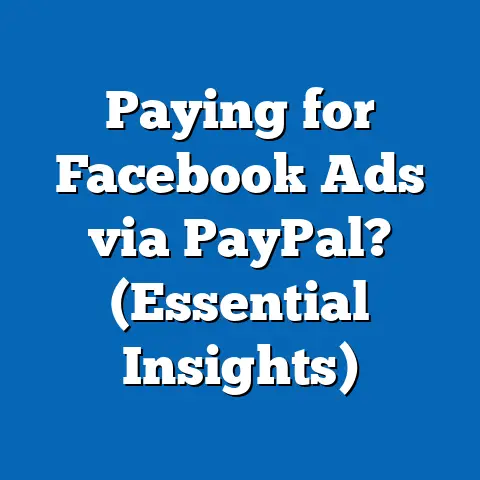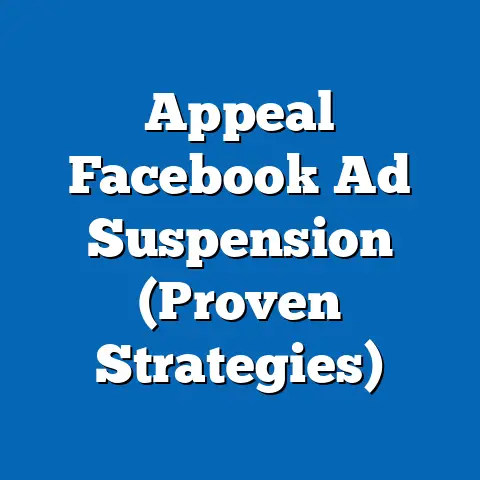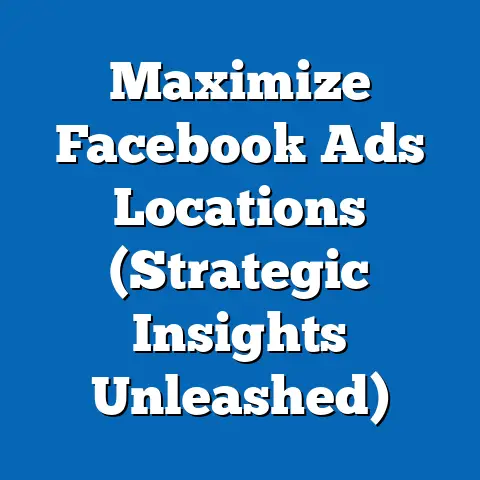Unlocking Meta fb ad Insights (Transparency Revealed)
In today’s digital landscape, understanding the performance of your Facebook (Meta) ads is not just beneficial; it’s absolutely crucial for survival. I’ve seen countless businesses, from small startups to established enterprises, pour their marketing budgets into Facebook Ads, hoping for a magic bullet. But without a clear understanding of what’s working and what’s not, you’re essentially throwing money into a black hole. That’s where unlocking Meta FB Ad Insights comes in.
Meta’s advertising platform is a powerhouse, offering unparalleled reach and targeting capabilities. Yet, its complexity can be daunting. The sheer volume of data can feel overwhelming, making it difficult to discern the truly actionable insights. That’s why I’m writing this guide: to help you navigate the intricacies of Meta’s advertising ecosystem and extract the valuable knowledge needed to optimize your campaigns.
This isn’t just about understanding the numbers; it’s about understanding your audience, your creative, and the entire journey your potential customers take. We’ll delve into the key metrics that matter, explore how to leverage audience insights for laser-focused targeting, and uncover the secrets to crafting high-performing ad creatives through A/B testing.
My goal is to empower you with the knowledge and tools you need to achieve better transparency, improved ad performance, and ultimately, a higher return on your investment. So, let’s dive in and unlock the potential of Meta FB Ad Insights, starting with understanding the advertising ecosystem.
Section 1: Understanding Meta’s Advertising Ecosystem
Think of Meta’s advertising ecosystem as a multifaceted machine, with each component playing a crucial role in the overall success of your campaigns. Understanding how these pieces fit together is the first step towards unlocking those valuable insights.
At the heart of this ecosystem lies the Ads Manager. This is your central command center, where you create, manage, and analyze your ad campaigns. It’s where you define your target audience, set your budget, design your ads, and track their performance. I’ve spent countless hours in the Ads Manager, tweaking settings and analyzing data to find the sweet spot for my campaigns and my clients’.
Next, we have Audience Insights. This tool is a goldmine of information about your target audience. It provides data on demographics, interests, behaviors, and even purchase patterns. Imagine having the ability to peer into the minds of your ideal customers! I’ve used Audience Insights to discover hidden interests and unexpected demographics that significantly improved my targeting.
Finally, there’s the Creative Hub. This tool is designed to help you brainstorm, create, and preview your ad creatives. It allows you to experiment with different ad formats, visuals, and messaging to see what resonates best with your audience. The Creative Hub has been invaluable in helping me visualize and refine my ad concepts before launching them to the masses.
These three components – Ads Manager, Audience Insights, and Creative Hub – work in synergy to provide advertisers with a comprehensive view of their campaigns. By understanding how they interact, you can make data-driven decisions that lead to better results.
The significance of understanding your audience cannot be overstated. It’s the foundation upon which all successful advertising campaigns are built. Knowing their demographics, interests, and behaviors allows you to craft messages that resonate with them on a personal level. Ad placement is equally important. Meta offers a variety of ad placements, including Facebook News Feed, Instagram Feed, Audience Network, and Messenger. Choosing the right placement can significantly impact your ad’s reach and engagement.
And of course, ad performance metrics are the lifeblood of any successful campaign. These metrics provide real-time feedback on how your ads are performing, allowing you to make adjustments and optimizations as needed. I’ve learned that consistently monitoring these metrics is the key to long-term success on the Meta platform.
Takeaway: Master the Ads Manager, leverage Audience Insights to deeply understand your target audience, and use the Creative Hub to experiment with different ad creatives. These are the foundational elements for unlocking Meta’s ad insights.
Section 2: Key Metrics for Unlocking Ad Insights
Now that we understand the basics of Meta’s advertising ecosystem, let’s delve into the key metrics that will help you unlock valuable insights. These metrics are the compass that guides your campaigns, providing you with real-time feedback on what’s working and what’s not.
-
Click-Through Rate (CTR): CTR measures the percentage of people who see your ad and click on it. A high CTR indicates that your ad is relevant and engaging to your target audience. I typically aim for a CTR of at least 1%, but the ideal benchmark can vary depending on your industry and target audience.
- Why it’s important: CTR is a direct indicator of ad relevance and appeal. A low CTR suggests that your ad is not resonating with your target audience, and you may need to adjust your targeting, creative, or messaging.
- How to interpret it: A high CTR (above 2%) indicates that your ad is highly relevant and engaging. A low CTR (below 0.5%) suggests that your ad needs improvement.
- How it relates to other metrics: CTR is closely related to other metrics such as cost per click (CPC) and conversion rate. A high CTR can lead to lower CPC and higher conversion rates.
-
Conversion Rate: Conversion rate measures the percentage of people who click on your ad and then complete a desired action, such as making a purchase, filling out a form, or downloading a resource. A high conversion rate indicates that your ad is effectively driving results.
- Why it’s important: Conversion rate is the ultimate measure of your ad’s success. It tells you how effectively your ad is turning clicks into customers.
- How to interpret it: A high conversion rate (above 3%) indicates that your ad is effectively driving results. A low conversion rate (below 1%) suggests that your landing page or offer needs improvement.
- How it relates to other metrics: Conversion rate is closely related to metrics such as cost per acquisition (CPA) and return on ad spend (ROAS). A high conversion rate can lead to lower CPA and higher ROAS.
-
Return on Ad Spend (ROAS): ROAS measures the amount of revenue you generate for every dollar you spend on advertising. A high ROAS indicates that your ad campaigns are profitable. I always strive for a ROAS of at least 3x, but the ideal benchmark can vary depending on your business model and profit margins.
- Why it’s important: ROAS is the ultimate measure of your ad campaign’s profitability. It tells you how much revenue you’re generating for every dollar you spend.
- How to interpret it: A high ROAS (above 4x) indicates that your ad campaign is highly profitable. A low ROAS (below 2x) suggests that your ad campaign needs improvement.
- How it relates to other metrics: ROAS is closely related to metrics such as conversion rate and cost per acquisition (CPA). A high conversion rate and low CPA can lead to a higher ROAS.
-
Cost Per Click (CPC) and Cost Per Acquisition (CPA): CPC measures the amount you pay for each click on your ad. CPA measures the amount you pay for each conversion. Lower CPC and CPA indicate that your ad campaigns are more efficient. I constantly monitor CPC and CPA to identify opportunities for optimization.
- Why they’re important: CPC and CPA are direct indicators of your ad campaign’s efficiency. Lower CPC and CPA mean you’re getting more results for your money.
- How to interpret them: Lower CPC and CPA are generally better. Compare your CPC and CPA to industry benchmarks to see how you stack up.
- How they relate to other metrics: CPC and CPA are closely related to metrics such as CTR and conversion rate. A high CTR and conversion rate can lead to lower CPC and CPA.
Click-Through Rate (CTR): CTR measures the percentage of people who see your ad and click on it. A high CTR indicates that your ad is relevant and engaging to your target audience. I typically aim for a CTR of at least 1%, but the ideal benchmark can vary depending on your industry and target audience.
- Why it’s important: CTR is a direct indicator of ad relevance and appeal. A low CTR suggests that your ad is not resonating with your target audience, and you may need to adjust your targeting, creative, or messaging.
- How to interpret it: A high CTR (above 2%) indicates that your ad is highly relevant and engaging. A low CTR (below 0.5%) suggests that your ad needs improvement.
- How it relates to other metrics: CTR is closely related to other metrics such as cost per click (CPC) and conversion rate. A high CTR can lead to lower CPC and higher conversion rates.
Conversion Rate: Conversion rate measures the percentage of people who click on your ad and then complete a desired action, such as making a purchase, filling out a form, or downloading a resource. A high conversion rate indicates that your ad is effectively driving results.
- Why it’s important: Conversion rate is the ultimate measure of your ad’s success. It tells you how effectively your ad is turning clicks into customers.
- How to interpret it: A high conversion rate (above 3%) indicates that your ad is effectively driving results. A low conversion rate (below 1%) suggests that your landing page or offer needs improvement.
- How it relates to other metrics: Conversion rate is closely related to metrics such as cost per acquisition (CPA) and return on ad spend (ROAS). A high conversion rate can lead to lower CPA and higher ROAS.
Return on Ad Spend (ROAS): ROAS measures the amount of revenue you generate for every dollar you spend on advertising. A high ROAS indicates that your ad campaigns are profitable. I always strive for a ROAS of at least 3x, but the ideal benchmark can vary depending on your business model and profit margins.
- Why it’s important: ROAS is the ultimate measure of your ad campaign’s profitability. It tells you how much revenue you’re generating for every dollar you spend.
- How to interpret it: A high ROAS (above 4x) indicates that your ad campaign is highly profitable. A low ROAS (below 2x) suggests that your ad campaign needs improvement.
- How it relates to other metrics: ROAS is closely related to metrics such as conversion rate and cost per acquisition (CPA). A high conversion rate and low CPA can lead to a higher ROAS.
Cost Per Click (CPC) and Cost Per Acquisition (CPA): CPC measures the amount you pay for each click on your ad. CPA measures the amount you pay for each conversion. Lower CPC and CPA indicate that your ad campaigns are more efficient. I constantly monitor CPC and CPA to identify opportunities for optimization.
- Why they’re important: CPC and CPA are direct indicators of your ad campaign’s efficiency. Lower CPC and CPA mean you’re getting more results for your money.
- How to interpret them: Lower CPC and CPA are generally better. Compare your CPC and CPA to industry benchmarks to see how you stack up.
- How they relate to other metrics: CPC and CPA are closely related to metrics such as CTR and conversion rate. A high CTR and conversion rate can lead to lower CPC and CPA.
Interpreting these metrics requires a holistic approach. Don’t focus on just one metric in isolation. Instead, look at the relationships between them. For example, a high CTR with a low conversion rate might indicate that your ad is attracting the right audience, but your landing page needs improvement.
Takeaway: Regularly monitor CTR, conversion rate, ROAS, CPC, and CPA to gauge the performance of your campaigns. Analyze the relationships between these metrics to identify areas for improvement.
Section 3: Leveraging Audience Insights for Targeting
Targeting the right audience is paramount to the success of any Facebook ad campaign. Imagine trying to sell winter coats to people living in the tropics – you’d be wasting your time and money! That’s where Meta’s Audience Insights tool comes in. It allows you to gather valuable data on your target audience, enabling you to create highly targeted campaigns that resonate with the right people.
Audience segmentation is the process of dividing your target audience into smaller groups based on shared characteristics, such as demographics, interests, and behaviors. This allows you to tailor your messaging and creative to each segment, increasing the relevance and effectiveness of your ads.
I’ve used Audience Insights to uncover hidden interests and unexpected demographics that significantly improved my targeting. For example, I was once running a campaign for a local coffee shop, and Audience Insights revealed that a significant portion of their target audience was also interested in local hiking trails. We adjusted our targeting to include this interest, and our ad performance skyrocketed.
Meta’s Audience Insights tool provides a wealth of data on your target audience, including:
- Demographics: Age, gender, location, education, and job title.
- Interests: Hobbies, passions, and activities.
- Behaviors: Purchase patterns, online activity, and device usage.
Using this data, you can create custom audiences and lookalike audiences. Custom audiences allow you to target people who have already interacted with your business, such as website visitors, email subscribers, or customers. Lookalike audiences allow you to target people who share similar characteristics to your existing customers, expanding your reach to new potential customers.
Creating these audiences is a straightforward process within the Ads Manager. You can upload customer lists, use website pixel data, or leverage engagement data from your Facebook page to create custom audiences. For lookalike audiences, you simply select a source audience (e.g., your customer list) and specify the desired size and similarity level.
Here are some examples of successful ad campaigns that utilized audience insights effectively:
- A clothing retailer used Audience Insights to discover that their target audience was highly engaged with sustainable fashion. They created a campaign highlighting their eco-friendly clothing line, resulting in a 30% increase in sales.
- A local gym used Audience Insights to identify that their target audience was interested in healthy eating and weight loss. They created a campaign offering free nutrition consultations, leading to a 20% increase in new memberships.
Takeaway: Leverage Audience Insights to gather data on your target audience and create highly targeted campaigns. Segment your audience based on shared characteristics and tailor your messaging and creative to each segment. Create custom audiences and lookalike audiences to expand your reach and improve your ad performance.
Section 4: Ad Creative and A/B Testing for Performance
Even the most perfectly targeted ad will fall flat if the creative isn’t compelling. Think of your ad creative as the bait that lures your target audience in. It needs to be visually appealing, attention-grabbing, and relevant to their interests.
Ad creative plays a crucial role in driving engagement and conversions. Your visuals, copy, and call-to-action all work together to create a compelling message that resonates with your target audience. I’ve found that using high-quality images and videos, crafting clear and concise copy, and including a strong call-to-action are essential for creating effective ad creatives.
But how do you know what ad creative will perform best? That’s where A/B testing comes in. A/B testing, also known as split testing, is the process of comparing two or more versions of your ad creative to see which one performs better. This allows you to make data-driven decisions about your creative and optimize your campaigns for maximum results.
Setting up A/B tests within the Ads Manager is a relatively simple process. You can test different ad formats, visuals, copy, and call-to-actions. The key is to test one variable at a time so you can accurately measure the impact of each change.
Here’s a step-by-step guide on how to set up A/B tests within the Ads Manager:
- Create a new campaign or ad set.
- Select the “A/B Test” objective.
- Choose the variable you want to test (e.g., ad creative, audience, placement).
- Create two or more versions of your ad, each with a different variation of the variable you’re testing.
- Set your budget and schedule.
- Launch your A/B test and monitor the results.
Interpreting test results requires careful analysis. Look at the key metrics, such as CTR, conversion rate, and ROAS, to see which version of your ad performed better. Once you have enough data, you can confidently choose the winning ad and scale your campaign.
Here are some quick tips for interpreting test results and making data-driven decisions:
- Focus on statistical significance: Make sure your results are statistically significant before making any decisions. A statistically significant result means that the difference between the two versions is unlikely to be due to chance.
- Test one variable at a time: Testing multiple variables at once can make it difficult to determine which variable is responsible for the change in performance.
- Be patient: A/B testing takes time. Allow your tests to run long enough to gather enough data to make informed decisions.
Takeaway: Ad creative is the bait that lures your target audience in. Use high-quality visuals, craft clear and concise copy, and include a strong call-to-action. A/B test different ad creatives to see which one performs better and optimize your campaigns for maximum results.
Section 5: Navigating Changes and Staying Ahead of the Curve
The world of digital advertising is constantly evolving. Meta’s algorithms and policies are constantly changing, and new trends emerge all the time. To stay ahead of the curve, it’s essential to adapt to these changes and continuously monitor your ad performance.
The evolving landscape of digital advertising can be daunting, but it also presents opportunities for innovation and growth. By staying informed about the latest trends and best practices, you can position yourself for success in the ever-changing digital landscape.
I’ve learned that the key to success in Facebook advertising is to be adaptable and responsive. Don’t be afraid to experiment with new strategies and tactics, and always be willing to adjust your approach based on the latest data.
There are numerous resources and tools that can help you stay informed about updates and trends in Facebook advertising, including:
- Meta Business Help Center: This is your go-to source for official information about Meta’s advertising platform.
- Industry blogs and publications: Stay up-to-date on the latest trends and best practices by reading industry blogs and publications.
- Online communities and forums: Connect with other advertisers and share your experiences and insights in online communities and forums.
Continuously monitoring your ad performance is crucial for identifying opportunities for optimization. Pay close attention to the key metrics, such as CTR, conversion rate, and ROAS, and look for patterns and trends. If you notice a decline in performance, investigate the cause and make adjustments to your campaigns accordingly.
Takeaway: The world of digital advertising is constantly evolving. Stay informed about the latest trends and best practices, and continuously monitor your ad performance to identify opportunities for optimization. Be adaptable and responsive, and don’t be afraid to experiment with new strategies and tactics.
Conclusion
Unlocking Meta FB Ad Insights is essential for achieving better transparency and improved ad performance. By understanding the key components of Meta’s advertising ecosystem, monitoring the essential metrics, leveraging audience insights for targeted campaigns, and A/B testing your ad creatives, you can optimize your campaigns for maximum results.
Remember, the world of digital advertising is constantly evolving. Stay informed about the latest trends and best practices, and continuously monitor your ad performance to identify opportunities for optimization. Be adaptable and responsive, and don’t be afraid to experiment with new strategies and tactics.
Now, I encourage you to dive into your own Facebook Ads Manager and start applying the insights shared in this article. Experiment with different targeting options, ad creatives, and A/B testing strategies to see what works best for your business. With consistent effort and a data-driven approach, you can unlock the full potential of Meta FB Ad Insights and achieve your advertising goals. Good luck!






